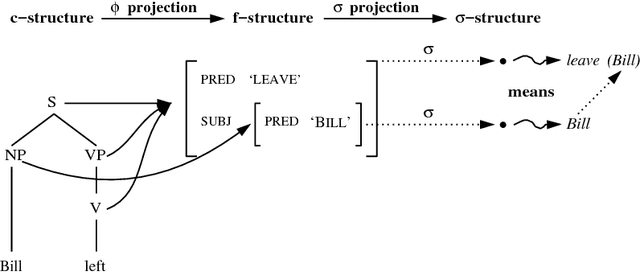John Lamping
Xerox PARC
Quantifiers, Anaphora, and Intensionality
Apr 29, 1995

Abstract:The relationship between Lexical-Functional Grammar (LFG) {\em functional structures} (f-structures) for sentences and their semantic interpretations can be expressed directly in a fragment of linear logic in a way that correctly explains the constrained interactions between quantifier scope ambiguity, bound anaphora and intensionality. This deductive approach to semantic interpretaion obviates the need for additional mechanisms, such as Cooper storage, to represent the possible scopes of a quantified NP, and explains the interactions between quantified NPs, anaphora and intensional verbs such as `seek'. A single specification in linear logic of the argument requirements of intensional verbs is sufficient to derive the correct reading predictions for intensional-verb clauses both with nonquantified and with quantified direct objects. In particular, both de dicto and de re readings are derived for quantified objects. The effects of type-raising or quantifying-in rules in other frameworks here just follow as linear-logic theorems. While our approach resembles current categorial approaches in important ways, it differs from them in allowing the greater type flexibility of categorial semantics while maintaining a precise connection to syntax. As a result, we are able to provide derivations for certain readings of sentences with intensional verbs and complex direct objects that are not derivable in current purely categorial accounts of the syntax-semantics interface.
Linear Logic for Meaning Assembly
Apr 18, 1995Abstract:Semantic theories of natural language associate meanings with utterances by providing meanings for lexical items and rules for determining the meaning of larger units given the meanings of their parts. Meanings are often assumed to combine via function application, which works well when constituent structure trees are used to guide semantic composition. However, we believe that the functional structure of Lexical-Functional Grammar is best used to provide the syntactic information necessary for constraining derivations of meaning in a cross-linguistically uniform format. It has been difficult, however, to reconcile this approach with the combination of meanings by function application. In contrast to compositional approaches, we present a deductive approach to assembling meanings, based on reasoning with constraints, which meshes well with the unordered nature of information in the functional structure. Our use of linear logic as a `glue' for assembling meanings allows for a coherent treatment of the LFG requirements of completeness and coherence as well as of modification and quantification.
* 19 pages, uses lingmacros.sty, fullname.sty, tree-dvips.sty, latexsym.sty, requires the new version of Latex
The Semantics of Resource Sharing in Lexical-Functional Grammar
Feb 13, 1995
Abstract:We argue that the resource sharing that is commonly manifest in semantic accounts of coordination is instead appropriately handled in terms of structure-sharing in LFG f-structures. We provide an extension to the previous account of LFG semantics (Dalrymple et al., 1993b) according to which dependencies between f-structures are viewed as resources; as a result a one-to-one correspondence between uses of f-structures and meanings is maintained. The resulting system is sufficiently restricted in cases where other approaches overgenerate; the very property of resource-sensitivity for which resource sharing appears to be problematic actually provides explanatory advantages over systems that more freely replicate resources during derivation.
* 8 pages, to appear in EACL-95. Requires eaclap.sty, tree-dvips.sty, tree-dvips.pro, lingmacros.sty, dgmacros.tex, lfgmacros.tex. Comments welcome.
Intensional Verbs Without Type-Raising or Lexical Ambiguity
Aug 22, 1994


Abstract:We present an analysis of the semantic interpretation of intensional verbs such as seek that allows them to take direct objects of either individual or quantifier type, producing both de dicto and de re readings in the quantifier case, all without needing to stipulate type-raising or quantifying-in rules. This simple account follows directly from our use of logical deduction in linear logic to express the relationship between syntactic structures and meanings. While our analysis resembles current categorial approaches in important ways, it differs from them in allowing the greater type flexibility of categorial semantics while maintaining a precise connection to syntax. As a result, we are able to provide derivations for certain readings of sentences with intensional verbs and complex direct objects that are not derivable in current purely categorial accounts of the syntax-semantics interface. The analysis forms a part of our ongoing work on semantic interpretation within the framework of Lexical-Functional Grammar.
A Deductive Account of Quantification in LFG
May 27, 1994Abstract:The relationship between Lexical-Functional Grammar (LFG) functional structures (f-structures) for sentences and their semantic interpretations can be expressed directly in a fragment of linear logic in a way that explains correctly the constrained interactions between quantifier scope ambiguity and bound anaphora. The use of a deductive framework to account for the compositional properties of quantifying expressions in natural language obviates the need for additional mechanisms, such as Cooper storage, to represent the different scopes that a quantifier might take. Instead, the semantic contribution of a quantifier is recorded as an ordinary logical formula, one whose use in a proof will establish the scope of the quantifier. The properties of linear logic ensure that each quantifier is scoped exactly once. Our analysis of quantifier scope can be seen as a recasting of Pereira's analysis (Pereira, 1991), which was expressed in higher-order intuitionistic logic. But our use of LFG and linear logic provides a much more direct and computationally more flexible interpretation mechanism for at least the same range of phenomena. We have developed a preliminary Prolog implementation of the linear deductions described in this work.
 Add to Chrome
Add to Chrome Add to Firefox
Add to Firefox Add to Edge
Add to Edge